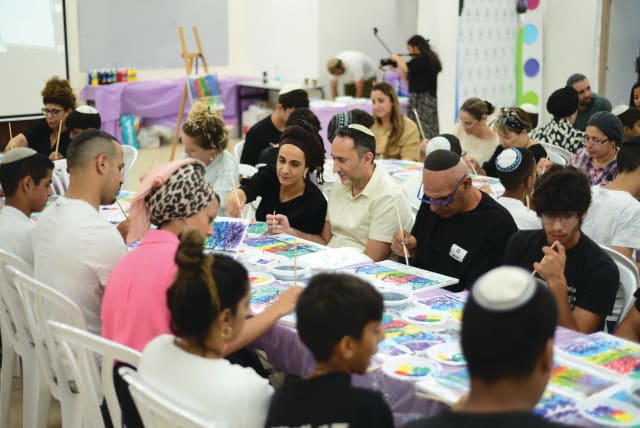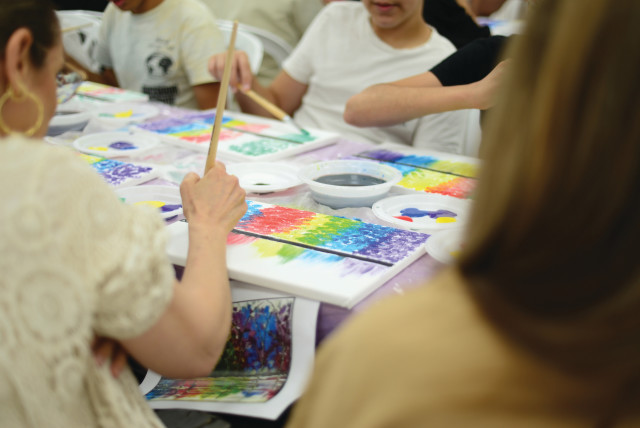Israeli school teaches English through hands-on art

Experimenting with new things was the approach chosen by Oshrit Mor, coordinator of AMIT Hammer’s English program and its Mofet program for gifted students.
“I had never liked or enjoyed art. I felt like it was pointless and had no meaning,” seventh-grader Eitan Mizrachi wrote in an essay for his school’s English-language newspaper last year.
His dim view of art brightened when he became one of 77 students in a new Art History in English program piloted at AMIT Hammer School in Rehovot.
“While art in primary school was glorified arts and crafts,” Mizrachi continued in his essay, “at Hammer we learn art history and theory and then how to apply this to our own artworks and life in general.”
For example, before recreating Claude Monet’s famous artwork Bouquet of Sunflowers, the students learned about Monet and experimented with his quick-brushing technique.
“We then tried this ourselves, which was fun. What I learned from this, that I can integrate into my life, is that there is always room to invent something new. Monet went against the culture of his time with his brush strokes. We, too, can challenge the culture we live in and experiment with new things!”
More than sitting there with a notebook
Experimenting with new things was exactly the approach chosen by Oshrit Mor, coordinator of AMIT Hammer’s English program and its Mofet program for gifted students.
She asked the administration to trial the Art History in English course, taught by art educator Nina Brenner. An olah (immigrant) from Florida, Brenner had been teaching various subjects to native English speakers for the previous three years at AMIT Hammer, which educates boys from grades seven to 12.
“Our school is not an Anglo school; we have the whole spectrum of Israeli students,” Mor emphasized.
“Our Mofet students have a lot of hours of math, science, and physics but only four hours of English per week, and I felt that was not enough. We wanted to do something new and unique so the students could do more than just sit there with a notebook.”
Mor’s original idea was a theater class in English, “but then we realized we already have a brilliant [art] teacher, Nina, who has an amazing way with the students,” she said. “So we built a syllabus around art, to let them learn English through art.”
Brenner and Mor opted to use an interdisciplinary approach, combining hands-on art, art history, and English.
“The course is taught only in English, and the students are almost forced to learn English – but they’re doing it naturally because when you’re using art as a tool to communicate, it’s a diverse experience. It has given them not only culture and art, which Israeli public school students rarely get, but also a creative outlet that they really need.”
Proud of their accomplishments
Each class studied a different artist – such as Picasso, Van Gogh, or Monet – and learned techniques to recreate some of their well-known works.
“These are not little kids,” Brenner observed about the seventh-, eighth- and ninth-graders in her pilot classes, some of whom come from difficult family circumstances. “They are young men, and they told me how proud they were of what they’d accomplished in the class. At the end-of-the-year student art gallery, their parents came to see their portfolios displayed, and I did a workshop for the parents so that they could experience what their kids did – all in English.”
Brenner, who has a master’s degree in gifted education from the University of Central Florida and has led art workshops throughout Israel and abroad for 10 years, said the course made a big impact beyond boosting English skills.
“The mental health benefits of incorporating art – not only in childhood education but also for teenagers – is so important. We have seen how Art History in English is changing many of the students’ lives, especially those who have difficulty learning and focusing,” she said.
Mor said the positive change was evident when she taught these same students in her English classes.
“They were able to speak without shyness, without fear of making mistakes. One boy, Ohad Baranes, said that at the beginning he thought I had lost my mind to combine two different subjects with English; but after participating in the course, he understood this kind of lesson is something special.”
Baranes put it this way (translated from Hebrew): “The combination between [art and English] made a lot of sense; it enriches and deepens. I learned about different artists and diverse [forms of] art, as well as English at a high level, and all this in an enjoyable and enriching learning environment.”
They found a way to do it
Mor credited AMIT Hammer principal Elihai Dadi and vice principal Daniel Zuzut for giving the course a chance.
“We are not a private school, but when I came to them with the idea and explained how much we needed it, they didn’t say ‘No, we have no budget.’ They found a way to do it.”
She continued, “With one stroke of a brush, we created and painted an entire world of learning, breaking the boundaries of the canvas and broadening horizons and thinking. This would not have been possible without a supportive management and a dedicated team in a true partnership process.”
Dadi said the innovative course is an example of “double creativity.”
“This kind of multidisciplinary learning that combines knowledge and skills in several subjects creates a deep and real connection for the students,” he said.
Painting during wartime
During this time of war, with classes moved to Zoom, Nina Brenner has continued giving Art History in English classes online – not only for students but also for AMIT Hammer staff members and parents.
“It has turned into something with a therapeutic aspect,” she said.
She is also booking virtual Israel-themed paint nights in the United States through her business, Paint Party Events.
Synagogues, Jewish community centers, and Jewish federations in several states have booked Brenner to give a live update of the current reality in Israel, and then guide participants step by step in creating a painting.
“Everyone goes home with a beautiful piece of artwork and also has the opportunity to support a small Israeli business during this war,” she said, adding that she is donating 10% of her profits to an organization that provides supplies to IDF soldiers.
“It’s an incredible opportunity to connect American Jews to Israel.”
Jerusalem Post Store
`; document.getElementById("linkPremium").innerHTML = cont; var divWithLink = document.getElementById("premium-link"); if (divWithLink !== null && divWithLink !== 'undefined') { divWithLink.style.border = "solid 1px #cb0f3e"; divWithLink.style.textAlign = "center"; divWithLink.style.marginBottom = "15px"; divWithLink.style.marginTop = "15px"; divWithLink.style.width = "100%"; divWithLink.style.backgroundColor = "#122952"; divWithLink.style.color = "#ffffff"; divWithLink.style.lineHeight = "1.5"; } } (function (v, i) { });

